10 Best Spotting Scopes of 2025 – Reviews & Buyers Guide
Last Updated on
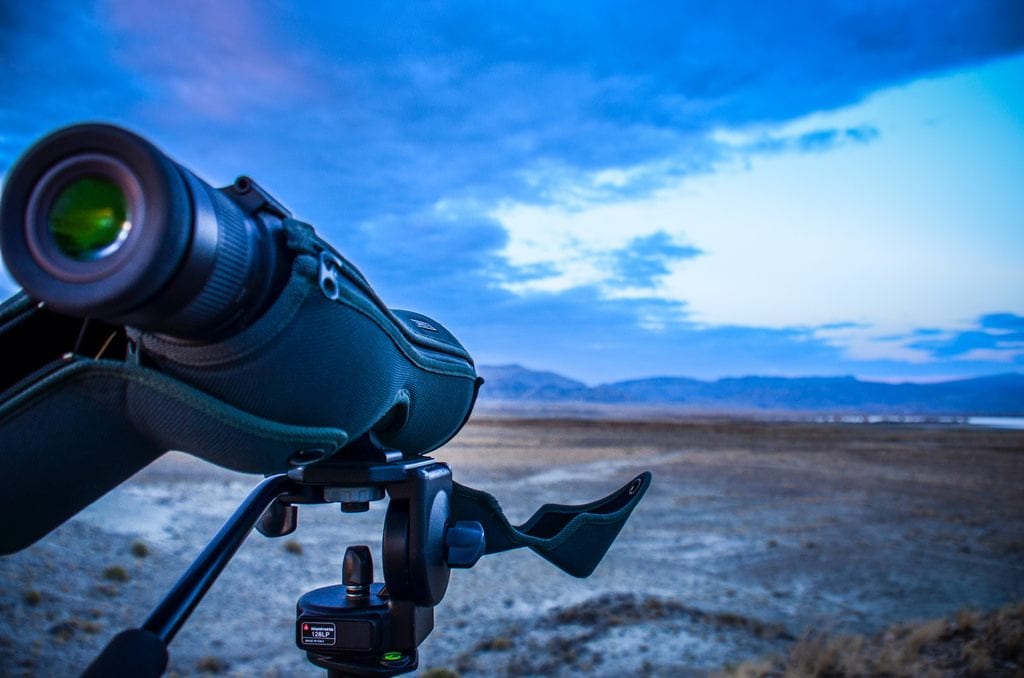
Of course, it’s not quite as simple as buying the first scope you see and trudging off into the wilderness. There are quite a few factors to consider, and if you’re new to using a scope, you may not even understand them all, much less know what to look for.
In the spotting scope reviews below, we’ll walk you through everything you need to know to find the perfect scope for your budget and situation.

A Quick Glance at Our Top Picks in 2025
| Image | Product | Details | ||
|---|---|---|---|---|
| Best Overall |
 |
Vortex Optics Razor HD |
|
CHECK PRICE |
| Best Under $500 |
 |
Vanguard Endeavour 65A |
|
CHECK PRICE |
| Best Value |
 |
Celestron Ultima |
|
CHECK PRICE |
 |
Gosky 20-60X 80 |
|
CHECK PRICE | |
 |
Bushnell Legend Ultra HD |
|
CHECK PRICE |
The 10 Best Spotting Scopes
1. Vortex Optics Razor Spotting Scope – Best Overall

Sometimes, the best overall is also the most expensive product on the market. The Vortex Optics Razor HD is just such a spotting scope. The triplet apochromatic lens gives you crystal-clear magnification in low light conditions without sacrificing color clarity in the process. Don’t think it’s only for use at dusk, however, as it boasts XR Plus anti-reflective coatings, ensuring it performs at a high level in broad daylight.
It performs as admirably at close range as it does at 1,000 yards, with the ability to focus on objects as close as 16.4 feet. The magnification ring turns smoothly and easily, allowing you to quickly switch between objects at various distances.
The Razor HD is surprisingly durable for such a sophisticated piece of equipment, boasting Amortek coatings to keep oil, dirt, and debris from fouling up the internal components. And while we wouldn’t recommend playing catch with it, the rubber armor should protect it in the event of an accidental drop or two.
However, while the scope itself offers some protection against damage, the bag it comes with leaves quite a bit to be desired. It’s large and bulky, with very little padding, and you’ll likely want to swap it out for something more formidable the first chance you get. When you’re paying a premium price for a top-of-the-line scope, you expect the total package to be solid.
Still, we think Razor HD is the best spotting scope this year
See: Vortex Spotting Scopes to Check Out!
- Triplet apochromatic lens excels in low light
- Amortek coatings shield internal components
- Performs well in broad daylight
- Close-range focus of 16.4 feet
- Protected by thick rubber armor
- Included bag is poor quality
- Expensive
- Related Read: Vortex Viper vs. Razor Spotting Scopes: Which Is Better?
2. Vanguard Endeavour 65A Spotting Scope – Best under $500
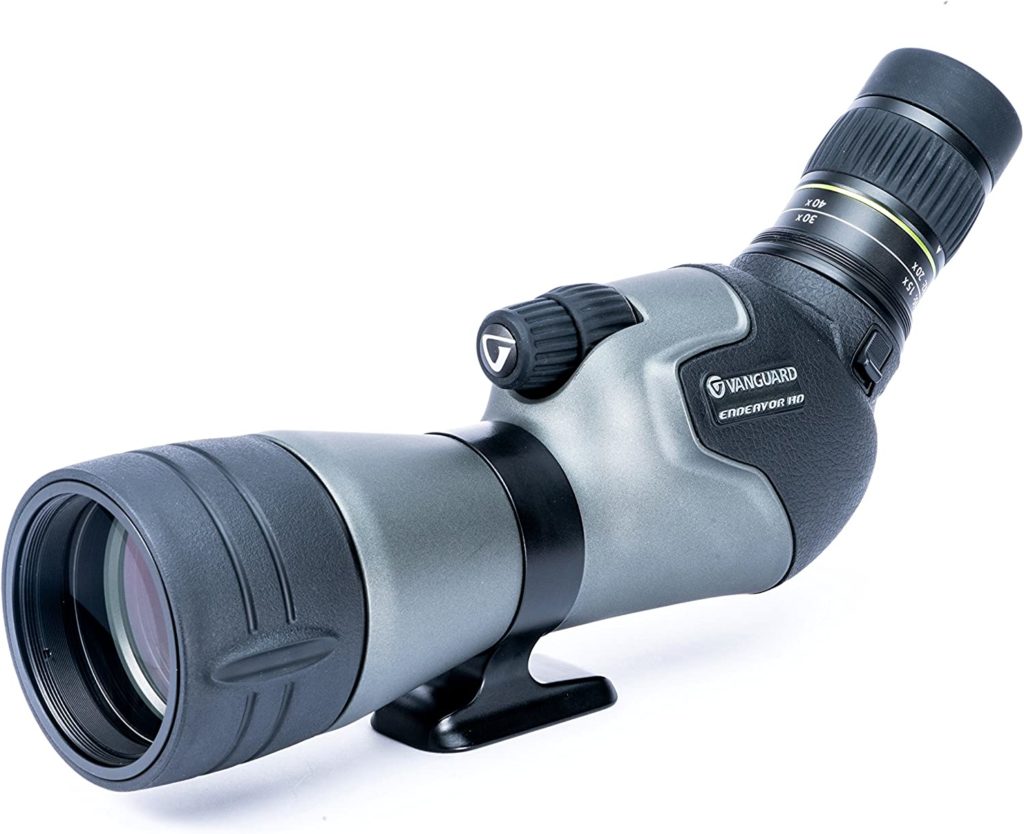
While it’s not quite up to the same standard as the Razor HD, the Vanguard Endeavour HD 65A manages to offer comparable abilities at a fraction of the price.
The lenses boast extra-low dispersion glass to give you vivid, accurate color depiction, and each one has been covered in advanced MultiGuard coatings to maximize light transmission.
Where the Endeavour really shines, however, is in its user-friendliness. It’s lightweight with an ergonomic grip, and the stacked controls are easy to use on the fly. The detachable eyepiece has a soft rubber cup and 20 mm of eye relief, making it comfortable for extended use.
This is an excellent scope for beginners, and it’s even forgiving of a few mistakes, thanks to its heavy-duty magnesium body. If you do manage to break it, though, don’t worry — it’s covered by a lifetime warranty.
As you might expect, there are a few areas in which the pricier Razor edges it out, most notably image quality. The Endeavour tends to be a little soft around the edges, which isn’t necessarily a deal-breaker — but it is one area in which the more expensive unit undoubtedly outperforms it. All in all, this budget-friendly scope should be able to get the job done for all but the most discriminating users, and it’s a good stepping stone to a more sophisticated model.
- Extra-low dispersion glass lenses
- MultiGuard coatings maximize light transmission
- Lightweight with ergonomic grip
- Backed by lifetime warranty
- Comfortable for extended use
- Image blurry around edges
3. Celestron Ultima Spotting Scope – Best Value
If you’re not prepared to make a sizable investment in a scope, the Celestron Ultima can rival its more costly competitors, but a budget-friendly price that puts it well within most users’ budgets.
You get a complete setup with your order, as in addition to the scope you’ll receive a tripod-mounting plate, a zoom eyepiece with T-adapter, and all the gear you’ll need to transport and clean it properly. Is any of this gear top-of-the-line? No, but it’s enough to get you started on the right foot for not a lot of money.
The scope itself boasts multi-coated optics designed to make colors pop and enhance contrast, allowing you to find your quarry even in dense brush. The focus dial is rather large as well, so sighting it in should never take more than a few seconds, even if you’re wearing gloves.
This is a mid-range scope, as it has a relatively pedestrian close focus distance of 26.2 feet and struggles at ranges beyond 200 yards or so. The multi-coated optics help brighten things up in low light, but at the expense of adding a slight rainbow sheen to everything you see.
No one is ever going to confuse the Celestron Ultima with an elite spotting scope, but then again, not everyone needs an elite spotting scope. If you’re just dabbling in bird watching or you want something to give to your kids, this is a respectable model that performs better than you have any right to expect, given its bargain-basement price. Which is why we think it’s the best spotting scope for the money.
- Very inexpensive
- Includes all necessary gear
- Quick and easy to focus
- Ideal for mid-range use
- Struggles beyond 200 yards
- Image suffers from rainbow sheen
- Included gear is only so-so
4. Gosky 20-60X 80 Spotting Scope
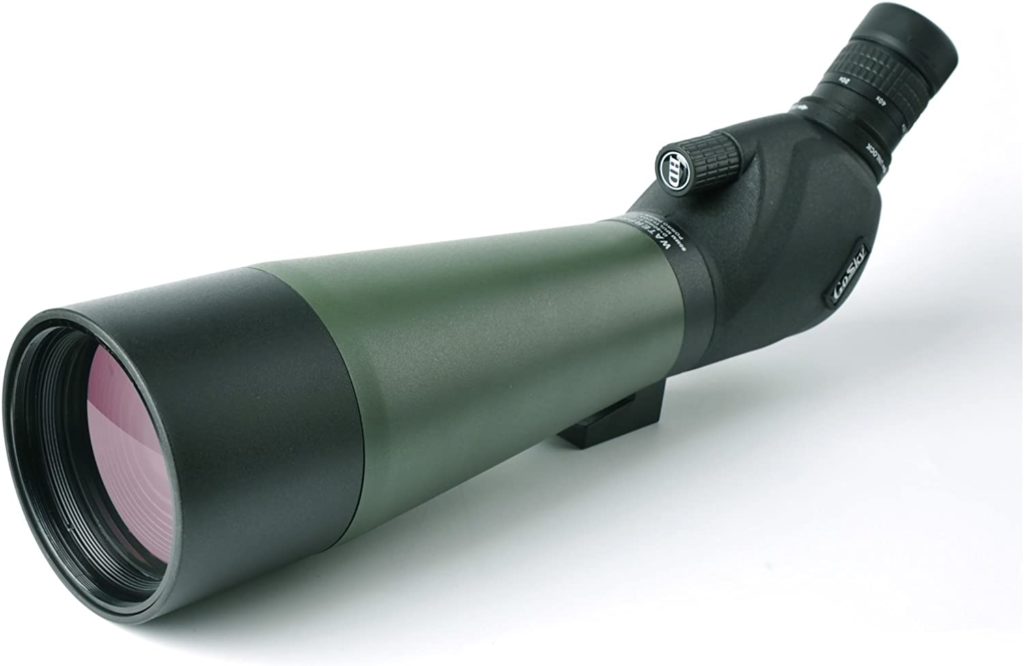
While not ideal for use on the move, the Gosky 20-60X 80 is a great choice for target shooting or other stationary pursuits.
Our favorite feature is the inclusion of a digiscoping adapter that allows you to attach your smartphone to the scope. The universal mount works with any model of phone, enabling you to zoom in closer and even record video of your best shots.
As you likely guessed from the name, the scope is capable of magnification from 20-60x, and while it claims to have a dynamic focusing system, we found that sharpening the image took a few seconds each time. This is another reason why the Gosky is better suited for stationary targets, as it reacts a little too slowly to track fast-moving birds or deer.
It also gives a scant 17 mm of eye relief, so users with glasses may get frustrated from constantly bumping up against the eyepiece.
You can likely use the Gosky at distances up to 800 yards, but be aware that it will get fairly blurry when set at the maximum magnification level. You’ll still be able to see at that distance, but picking up small details isn’t going to be easy.
- Ideal for target shooting
- Digiscope adapter for pairing smartphones
- Universal phone mount
- Focusing is tedious
- Not good for moving objects
- Limited amount of eye relief
- Blurry at higher magnification levels
5. Bushnell Legend Ultra Spotting Scope
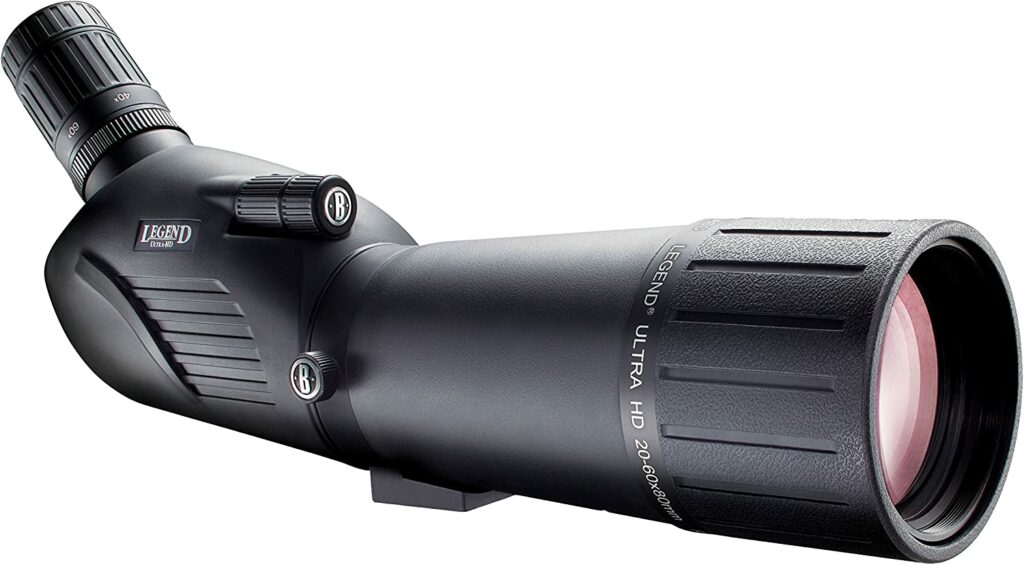
The Bushnell Legend Ultra is not the most portable spotting scope at 16.5 inches long and weighing a hefty 80 ounces, but its solid construction inspires confidence. However, it’s small enough to store in a backpack or rifle case, but those 6.5 pounds might start to wear you down in the field.
Positively, the Legend boasts a 80 mm objective lens that’s capable of up to 60x magnification – on par with some of the other models on this list. The 2-speed dual focus control keeps images sharp while you’re in motion.
It performs admirably in inclement weather, thanks to the RainGuard HD coating that protects it from rain, sleet, and other moisture. This unit is advertised as waterproof so you won’t have to panic if it gets wet.
The Legend Ultra works better if your target is further away, as it has a close focus distance of 35 feet. Bak-4 prisms provide a respectable 110 feet at 1,000 yards (20x), 51 feet at 1,000 yards (60x), but don’t expect to count every feather on a bird at that range; this scope is more for finding things in the mid-to-long rane distance.
The kit includes most of the basics, including a tripod, but you won’t be wowed by any of the accompanying equipment. The lens covers are especially annoying, as they refuse to stay on for very long, especially if you’re jostling the scope while traveling.
And then… You see the price tag. Sure, it’s not as pricey as our #1 pick, the Razor HD, but you’ll be paying for premium features like the ED Prime Extra-Low Dispersion glass and multicoated optics. We wouldn’t necessarily recommend the Bushnell Ultra to be your first spotting scope, but it’s an excellent choice if you want something substantial for mid-to-long range viewing.
- Excellent magnification
- Stable viewing while in motion
- RainGuard HD coating for wet conditions
- Works well at mid-to-long range
- Big and heavy
- Lens covers won’t stay on
- Expensive
- Not for close-up viewing
6. CREATIVE XP HD Spotting Scope with Tripod

If you’re looking for a decent package-deal spotting scope at an amazing price, you don’t need to look any further than the Creative XP HD Spotting Scope with tripod. The scope has a 20x-60x magnification power with two fine adjustment knobs that’ll help you dial in the clearest possible image whether at closer or extreme distances. And it’s also got a pretty large eye relief for those who like to sit back on the lens or those who wear glasses.
One of our favorite features has got to be the fact that this scope was made without forfeiting any merits of quality construction. The scope is nitrogen-purged and sealed with an O-ring to prevent any water, fog, or shock damage. Plus it comes with an extendable sunshade so there isn’t any glare from unwanted sun rays.
And that’s not it. This scope comes with a bevy of cool extras such as a tripod, protective case, cell phone adapter, and photo clicker.
- Great magnification capability
- Large eye relief
- Two fine adjustment knobs
- Top-notch construction
- Lots of extras
- Learning curve on how to fine-tune adjust
- Related Read: Monocular vs Spotting Scope: Which Should You Choose?
7. LANDOVE 20-60X80 BAK4 Prism Spotting Scope
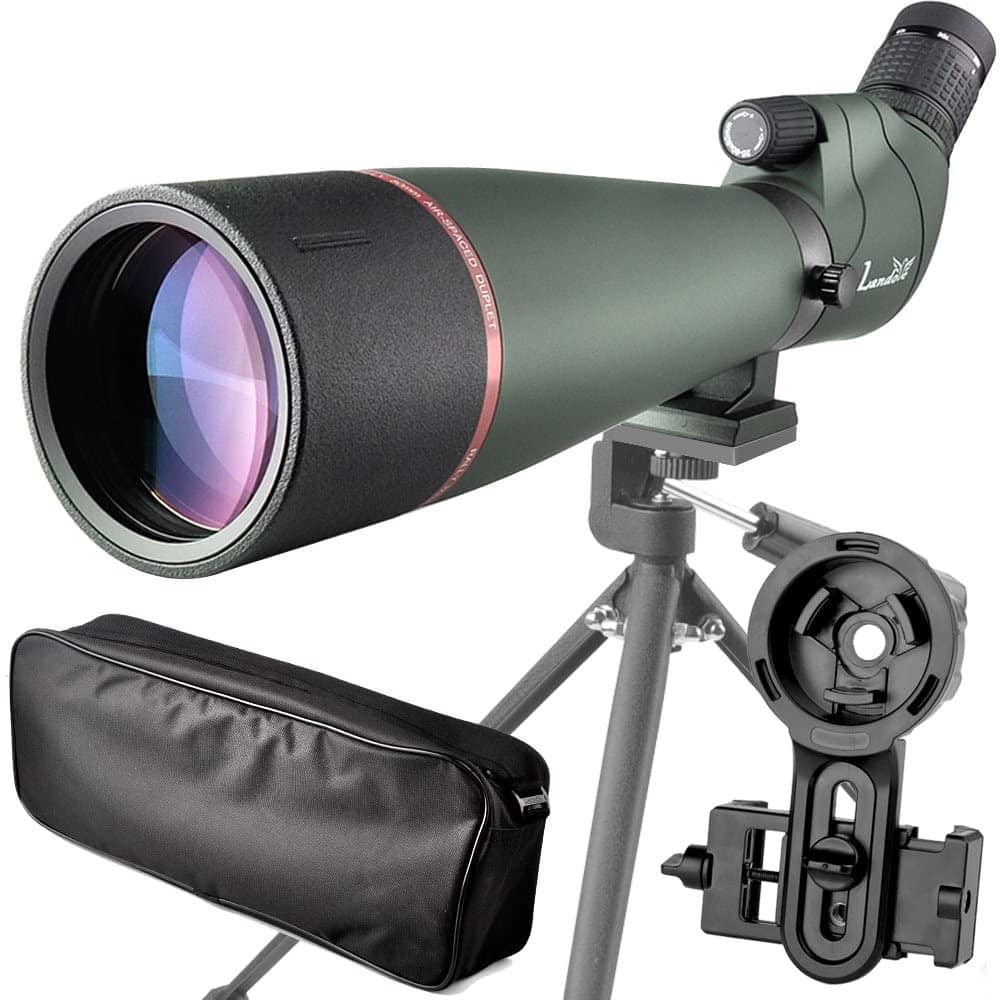
On the surface, there’s not a lot of difference between this spotting scope and our number one pick. However, the LANDOVE BAK4 Prism spotting scope is about 10 times cheaper. It’s equipped with BAK-4 Porro optics to provide a crisp, clear image at up to 60x magnification. They’re also nitrogen-purged and built like a tank in order to maintain the best structural integrity as possible.
So, aside from price, what keeps this scope from the top of the list? It’s not in the same class – at all. This scope only has one quick-adjust knob limiting the amount of fine-tuning you can do. But that might be just ok with some people, as learning to fine adjust your scope properly takes time.
- Crisp and clear magnification
- Great eye relief
- Solidly built construction
- Only one quick-adjustment knob
8. SVBONY SV406P Spotting Scope HD Dual Focus
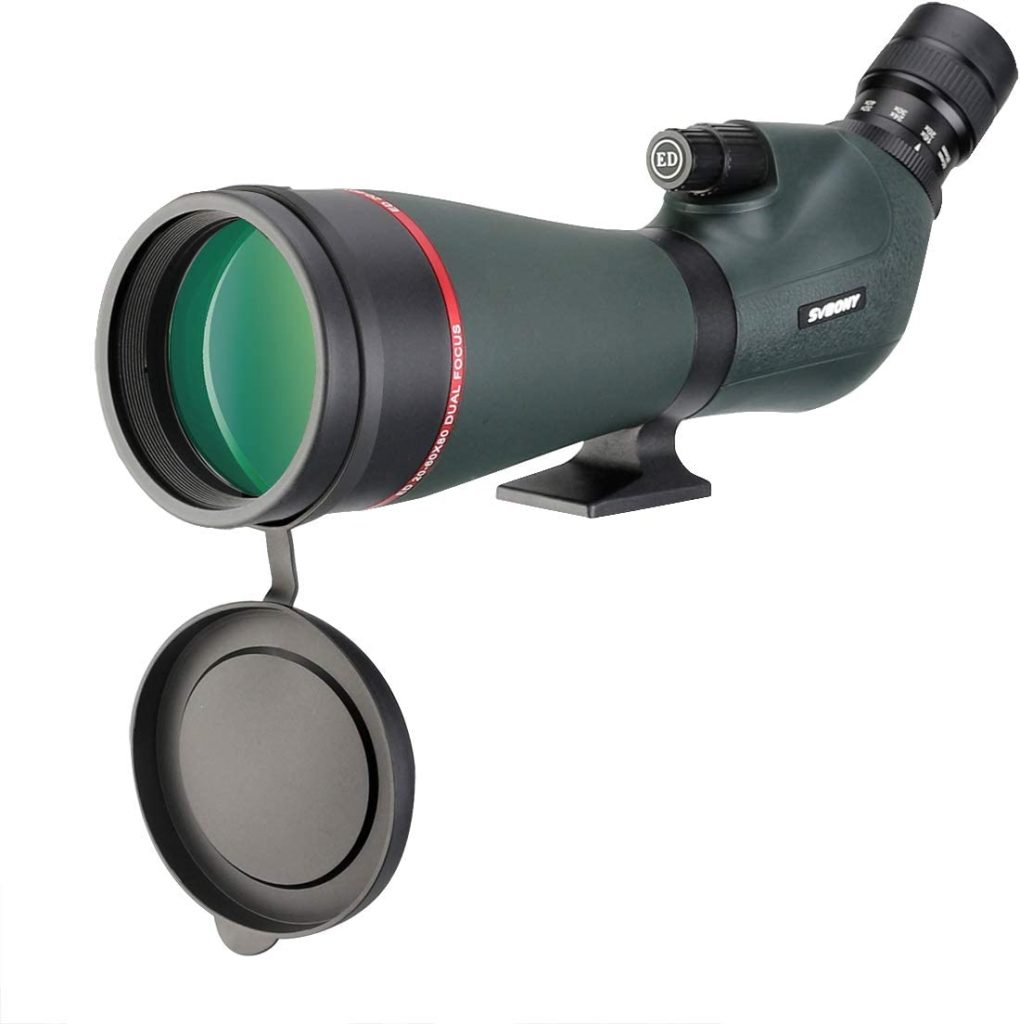
The SVBONY SV406P is a decent scope on par with the Celestron. It comes built with three separate objective lens structures that provide some of the sharpest clearest images around—even at high magnification powers. It also comes with a detachable eyepiece that’s built to astronomical standards so you can interchange your favorite eyepiece as needed.
It’s also got a fast, smooth dual-speed focusing design. This allows you to get in focus quickly and is especially helpful if taking pictures during bird watching. The SVBONY is built with the utmost care and is IPX7 water and fog proof. It’s not the most premium option when shopping for a spotting scope, but you can get equal or better scopes for the same price. This is almost twice as much as some of the other selections on this list.
- Three different objective lens structures
- Crystal clear views even at high powers
- Dual speed focusing
- Very expensive for what it can do
9. Amcrest Spotting Scope for Target Shooting w/Tripod
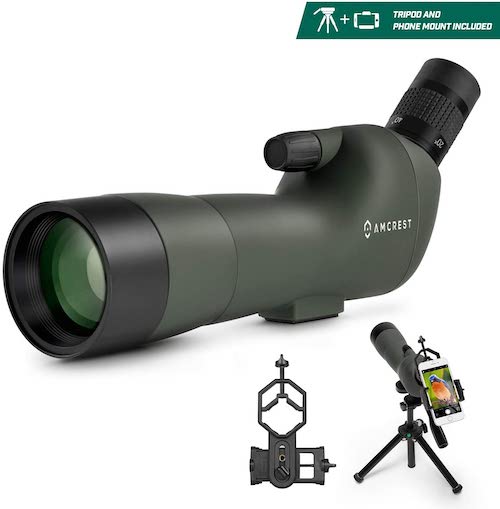
If you’re looking for a solid budget choice for a spotting scope, this Amcrest may be what you’re needing. It comes with a 60x magnification power with a 60mm objective lens diameter to provide a larger field of view. The Amcrest features a BK7 Porro Prism in order to deliver the sharpest images it can.
The scope is contained within an IPX6 waterproof housing that provides a durable exterior while protecting the optics. And the scope also comes with a smartphone adapter and carrying case. It’s a great choice for those just starting out with glassing.
However, it’s missing some of the bells and whistles of other scopes. For example, the smartphone adapter doesn’t really hold modern phones very well, if at all. And the associated tripod isn’t of the best quality. It feels kind of flimsy compared to other options.
- Great budget option
- IPX6 Waterproof Housing
- BK7 Porro Prism
- Smartphone adapter designed for older phones
- Tripod is low quality
10. Barska 30-90×90 Waterproof Colorado Spotter Scope and Tripod
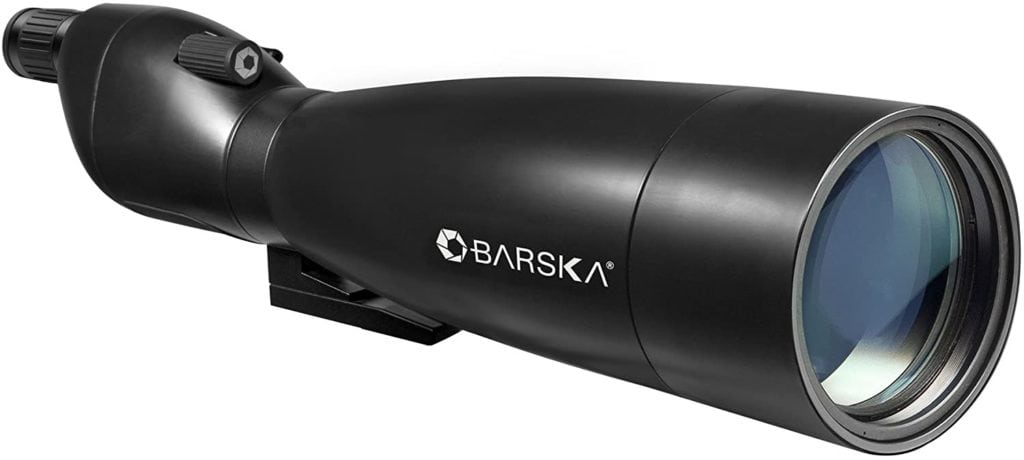
The Barska Colorado Spotter Scope is a decent choice if you’re looking for that extra bit of magnification. This has the highest magnification power on our list. And the 90x power does well with the 90mm objective lens diameter.
However, there are a few issues with this spotting scope that make it a little less than desirable. First, there’s a much smaller eye relief than other scopes. At 14.8mm, anyone with corrective lenses is going to have a tough time really seeing anything through this. Also, the tripod leaves much to be desired. It just feels unstable, and that’s not a good feeling when balancing an expensive piece of equipment.
- High magnification power
- Large lens diameter works well at higher magnification
- Terrible tripod
- Very little eye relief
- Not terribly clear at long distances
- Best suited for use as secondary scope

Buyers Guide: Choosing the Best Spotting Scope
Knowing about the different types of spotting scopes, which features to look for and how to get the most out of them will help make your decision so much quicker and easier. If this sounds appealing then read on for our buying guide!
Straight vs Angled?

There are two main types of spotting scopes for you to consider: straight and angled. Take a look at the various pros and cons of both and you’ll soon have an idea as to which is best for you!
Straight Spotting Scopes

Straight spotting scopes are the one-size-fits-all of the device but angled scopes seem to dominate the market. The best thing about straight scopes is their versatility. They’re excellent for sighting on the go and don’t need a tripod to be as effective at target acquisition. You’re also not crouched over the scope, making yourself less vulnerable to obstacles and threats in the field. Straight scopes can be used for just about every occasion.
- Easier to use from a vehicle
- Less likely to collect snow and water when not in use
- Easier to store in a backpack
- Target acquisition is faster
- Very uncomfortable to use at uphill angles
- Crouching can be awkward
- Tripod needs to be taller, which can be problematic in windy conditions
Angled Spotting Scopes
If you’re going to be doing a lot of bird watching or stargazing, we recommend an angled scope since it easily allows you to look upwards with less discomfort. They’re also better for looking uphill or into the sky. Plus, you have digiscoping capability that you won’t get with most straight scopes. On the downside, angled scopes are harder to use on the move – they’re much better on a tripod – and target acquisition takes some getting used to.
- Can use a shorter tripod
- Arguably more comfortable
- Better suits to looking up steep terrain
- Can easily switch between people of different heights
- Better support for digiscoping (using your phone to photograph and film)
- A little more difficult to store away because of the shape
- Not as capable with spotting downhill
- Can collect snow and water on the lens when not in use
How much magnification do I need?
Spotting scopes are typically more powerful than binoculars and typically have a variable zoom of 15-45x or 20-60x. You’re unlikely to need anything more than 60x as the conditions of the atmosphere limit how much you can see. Greater magnifications work best at high altitudes and in dry climates but struggle in low altitude and humid climates.
What about the objective lens?
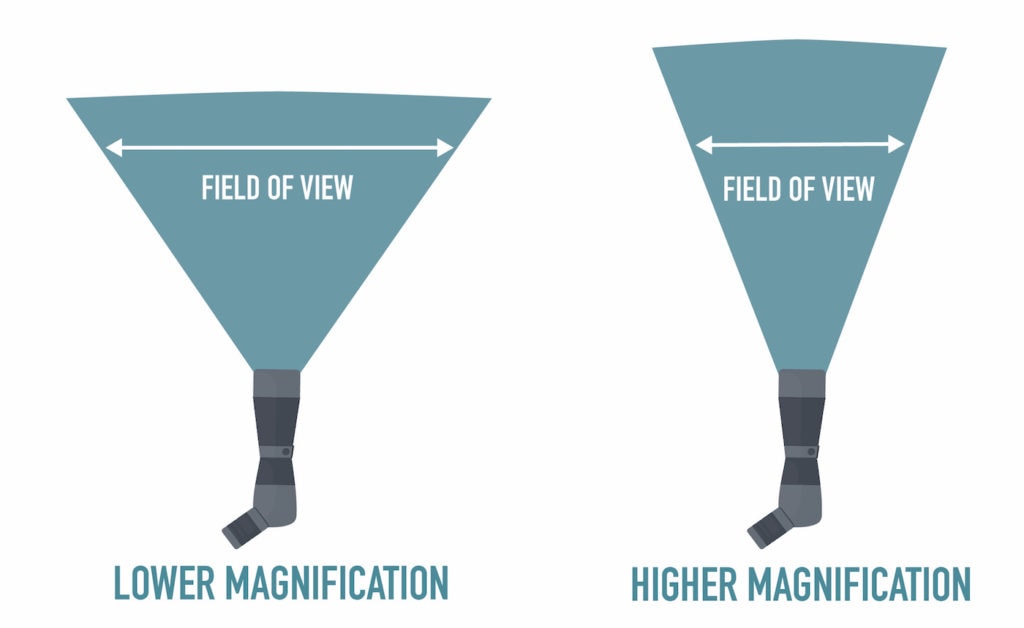
The objective lens of a spotting scope is also very important since it dictates how well you can see. As a rule, the bigger the objective lens, the more powerful it will be. Larger lenses are typically between 60 and 100mm in size and will gather more light resulting in clearer, brighter images. A wider field of view is also provided.
Remember that the bigger the objective lens, the heavier the spotting scope will be. If you’re planning on staying in one place with your spotting scope then an 80-100mm lens may be ideal. Those who are moving around such as on hikes may appreciate a smaller 50-60mm lens.
However, it’s important to note that greater magnification equals a narrower field of view. Lower mag spotting scopes allow give you a wider field of view.
How important is eye relief?
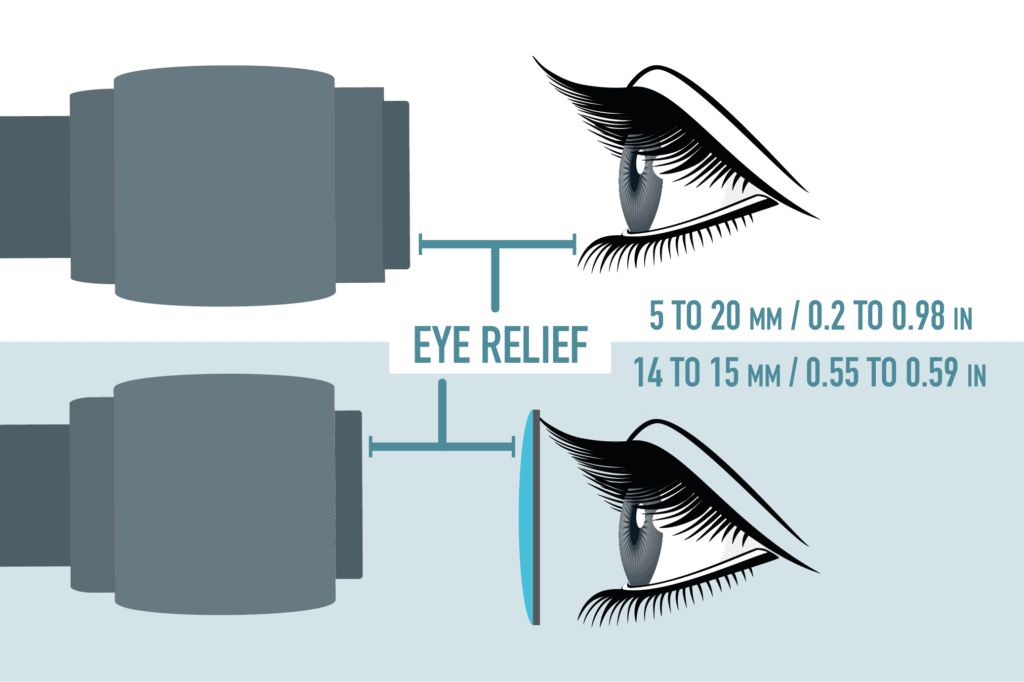
Eye relief is very important when wearing prescription glasses or sunglasses when you use your spotting scope. It’s annoying having to constantly take glasses off every time you look through the scope. For this reason, you should look for a product that offers long eye relief. This refers to the distance from which your eye can be from the eyepiece while still being able to see the full view. We recommend at least 14mm of eye relief, though, 17mm would be adequate.
Do I need to have a tripod?

Because spotting scopes use high magnifications, tripods are highly recommended. A good tripod will help reduce the image shakiness that can occur which will help provide you with better quality visuals. Of course, spotting scopes don’t require tripods but it’s always good to have the option. In some cases, tripods are included with the spotting scope upon purchase. But in most cases, these need to be bought separately. We advise that you get the best tripod that you can realistically afford for the best experience with your new product.
Is there anything else?
Before you make that purchase, consider these final points:- Most spotting scopes are both waterproof and fog proof. We consider this to be essential.
- Given the price of an average spotting scope, it’s well worth looking for a product that offers a good warranty. The best spotting scopes have lifetime warranties and offer great customer service when issues arise.
- The size and weight of your spotting scope may be very important to you if you plan on taking it on long hikes and hunts.
- Try to set a budget that you’re happy with. There are spotting scopes to suit all budgets from $200 right up to $2000. The more you spend, the greater the optical performance. You’ll also be able to expect more features.
- Which accessories are included with your spotting scope? Most products come with at least a lens cloth and carry case. You may also wish to purchase a tripod.
- Prices of spotting scopes can vary a great deal. You may find a bargain by shopping around. It’s also good practice to read consumer reviews for a complete impression of a particular product.

Conclusion
If you’re a hunter, marksman, or nature enthusiast, buying a spotting scope will open up a whole new world of possibilities for you. You’ll be able to see small details with incredible clarity at distances up to 1,000 yards, allowing you to accurately sight in a rifle or identify a rare species of bird.
For those who want the best scope on the market (and are willing to pay the price), the Vortex Optics Razor HD is hard to beat and best overall spotting scope. It boasts a triplet apochromatic lens to give you a clear picture in low-light conditions, and its XR Plus anti-reflective coatings let you see the world perfectly even in direct sunlight. It’s not as fragile as you’d expect a sophisticated piece of optics equipment to be, either, thanks to its Amortek coating that safeguards the internal components.
Users on a budget will find that the Vanguard Endeavour HD 65A can rival the Razor HD in many ways, but at a fraction of the price, earning its best spotting scope under $500 award. While not quite as capable of providing crystal-clear images, it will still bring the world around you into crisp focus, as it has extra-low dispersion glass lenses with MultiGuard coatings. It’s also backed by a lifetime warranty, making it a smart choice for users who are rough on equipment.
The Celestron Ultima has decent optics at a friendly price. It’s the best spotting scope for the money and a good gateway product for beginners.
You’ll be amazed at everything you can see once you have a high-quality spotting scope readily available. Regardless of whether you’re out at dawn, dusk, or the middle of the day, the options on this list will ensure that nothing can hide from your gaze. The only downside is you’re now officially out of excuses for anything you miss!
Table of Contents
- A Quick Glance at Our Top Picks in 2025
- The 10 Best Spotting Scopes
- 1. Vortex Optics Razor Spotting Scope – Best Overall
- 2. Vanguard Endeavour 65A Spotting Scope – Best under $500
- 3. Celestron Ultima Spotting Scope – Best Value
- 4. Gosky 20-60X 80 Spotting Scope
- 5. Bushnell Legend Ultra Spotting Scope
- 6. CREATIVE XP HD Spotting Scope with Tripod
- 7. LANDOVE 20-60X80 BAK4 Prism Spotting Scope
- 8. SVBONY SV406P Spotting Scope HD Dual Focus
- 9. Amcrest Spotting Scope for Target Shooting w/Tripod
- 10. Barska 30-90×90 Waterproof Colorado Spotter Scope and Tripod
- Buyers Guide: Choosing the Best Spotting Scope
- Conclusion
About the Author Robert Sparks
Robert’s obsession with all things optical started early in life, when his optician father would bring home prototypes for Robert to play with. Nowadays, Robert is dedicated to helping others find the right optics for their needs. His hobbies include astronomy, astrophysics, and model building. Originally from Newark, NJ, he resides in Santa Fe, New Mexico, where the nighttime skies are filled with glittering stars.
Related Articles:
How to Clean a Refractor Telescope: Step-by-Step Guide
How to Clean a Telescope Eyepiece: Step-by-Step Guide
How to Clean a Rifle Scope: 8 Expert Tips
Monocular vs Telescope: Differences Explained (With Pictures)
What Is a Monocular Used For? 8 Common Functions
How to Clean a Telescope Mirror: 8 Expert Tips
Brightfield vs Phase Contrast Microscopy: The Differences Explained
SkyCamHD Drone Review: Pros, Cons, FAQ, & Verdict




